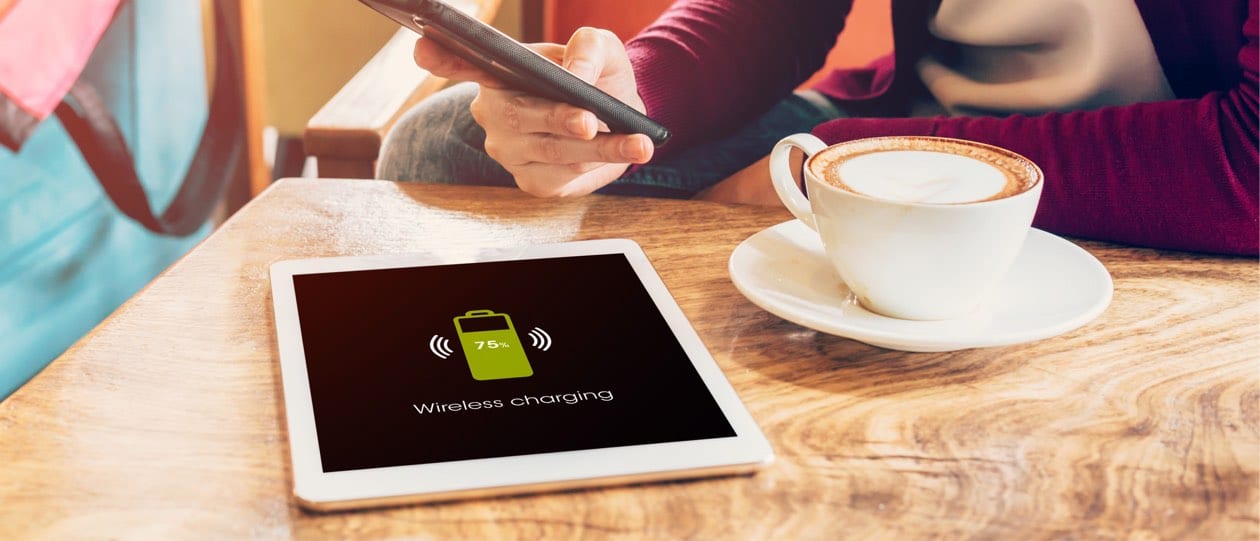The STWBC-EP transmitter and the STWLC33 receiver are ST’s first 15 W wireless charging solutions. Compatible with the Qi 1.2 Extended Power Profile protocol, they offer a complete set up for medical devices, smartphones, and tablets, among many others. The time when wireless charging was an optional feature in a niche market is over. It is something the public actively looks for because the technology is ubiquitous, meaning that omitting it is now the exception rather than the norm. However, adding wireless charging can be complicated and a mistake could ruin a product’s power efficiency, or even cause malfunctions. Hence, a complete solution made of the STWBC-EP and the STWLC33 is a game changer because it brings all the glory of this sought-after technology and none of its headaches.
ST already has a vast catalog of wireless charging products, most certified for a lower power output. We’ve covered some of them in the Life.Augmented Blog, such as the STWBC-WA and STWLC04 that make wireless charging for wearables easy. More recently, these devices took center stage at this year’s Developers Conference with demos and presentations aimed at helping engineers and decision makers understand the technology and its implementation. Today, as the industry inevitably moves toward more powerful devices and faster charging times, ST didn’t merely add a more prominent coil, but thoroughly reviewed its hardware and software to bring original features, and new levels of efficiency.
What Does 15 W Wireless Charging Mean Today?
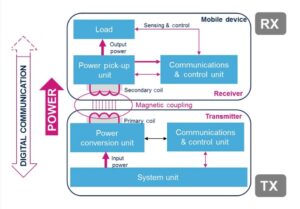
Today, wireless induction charging is dominating the consumer electronics’ market when it comes to mobile devices. Very simply, the technology uses the natural relation between an electric and magnetic field to transfer power to a battery. A transmitter, more commonly referred to as a “charger,” is plugged to the mains and converts the power into a high-frequency alternating current that a circuit will carry to an induction coil (known as the primary coil), causing an oscillating magnetic field. If the secondary coil in the mobile device (receiver) is close enough, it will pick up this magnetic flux and start to resonate as well. From there, Faraday’s law of induction dictates that the system can convert the magnetic field back into an alternating current to charge a battery or power a device.
Standards quickly emerged to ensure multiple companies would agree on the technology’s implementation, so devices from different manufacturers could work together. Hence were born Qi and AirFuel Inductive, and because ST aims to serve as many customers, industries, and people as possible, it is a member of both the Wireless Power Consortium (Qi) and the AirFuel Alliance. As a result, the STWLC33 is compatible with both inductive standards, guaranteeing that mobile devices can start charging regardless of the chargers’ protocol. Since the STWBC-EP transmitter implements the Qi 1.2 Extended Power Profile, the only 15 W wireless induction charging standard vastly supported at the moment, it doesn’t offer AirFuel Inductive. However, ST already has various dual-standard receivers, such as the STWLC03, and the aforementioned STWLC33, thus ensuring that whatever the protocol, companies have access to a complete solution with both transmitters and receivers working together to optimize performance.
How Does Backward Compatibility Work?
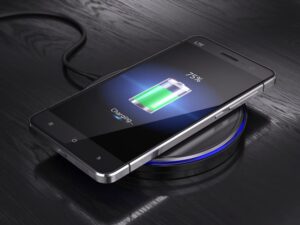
One reason wireless induction charging has won the heart of the industry is that compared to other methods, it is subject to less leakage current and fewer electromagnetic interferences. However, with the introduction of 15 W solutions, new optimizations take the efficiency one step further. For instance, on some of the components designed for 5 W wireless charging, the control system adjusts the frequency and duty cycle to obtain the best performance. On the new 15 W transmitter reference board based on STWBC-EP, the design uses primarily voltage control, only modifying the frequency if necessary.
This approach means that the frequency remains relatively stable, and the transmitter’s reference board can accept a much more comprehensive range of supply voltages, which now span from 5 V to 13 V, instead of just 5 V previously. The reference board will identify itself to the receiver as a 5 W Baseline Power Profile transmitter when supplied at 5 V, and as a 15 W Extended Power Profile transmitter when supplied at 12 V. This ensures that the transmitter remains compatible with previous 5 W Qi receivers, and can quickly adapt to all the versions of the Qi protocols.
Backward compatibility is also baked into the receivers, and the STWLC33 has a system that can optimize its performances based on the type of transmitter it is coupled with. Very simply, if the receiver deals with a 5 W charger, it will automatically set its output voltage to 5 V. However, if the system is interacting with a 15 W solution, the voltage goes up to 10 V. By increasing the voltage, the receiver will source lower current, and will, therefore, minimize power losses, which significantly improves thermal and electrical efficiency.
Special Hardware Optimizations
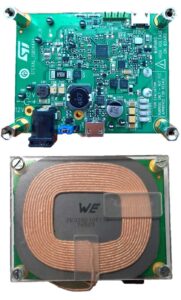
Hence, it’s easy to see that the STWLC33 received many optimizations, which does explain why its package is smaller than the previous model (STWLC03), at 3.97 mm x 2.67 mm, despite being capable of outputting three times more power. Furthermore, it uses an LDO (Low Drop Out), rather than a buck converter, to handle the final stage regulation. However, ST smartly adjusts the input voltage at the LDO according to the output to keep the drop to a minimum, ensuring that the dissipation remains exceptionally low. Ultimately, all these tweaks mean that the STWLC33 is the first wireless receiver on the market today capable of providing an output voltage that can charge two-cell lithium-ion batteries.
At this point, it’s easy to see why the STWBC-EP transmitter and the STWLC33 receiver stand head and shoulder above the competition, but manufacturers have the choice to use one and not the other. The ST solution is flexible enough to work with engineers that may already have certain imperatives that require the use of different components. However, the new bidirectional feature of the Qi 1.2 Extended Power Profile protocol makes an excellent case for carefully choosing both transmitter and receiver. Previously, data communication only traveled from the receiver to the transmitter. However, given the vastly increased power levels, the new protocol implements bidirectional communication. Hence, the transmitter can now also send data to the receiver so both can more accurately control the charging operations to make sure the system remains safe and optimized.
Special Software Optimizations
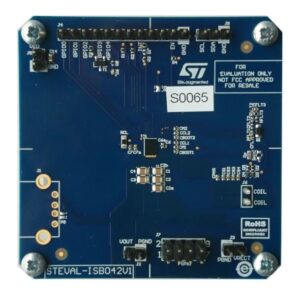
ST’s enhancements also extend beyond the hardware architecture to offer a unique and efficient firmware. For example, the STWBC-EP has a short power burst when in analog ping mode, thanks to its software that quickly wakes the system up to check if a potential receiver is present. Since the charger spends most of its time idle, just checking whether or not it must start transmitting power, this burst mode is of the utmost importance because it will have a significant influence on the average power consumption. Often, a competing firmware will require a more prolonged burst to ensure that the detection operations are adequately executed. The beauty of the ST firmware is its ability to do the same while taking a lot less time and thus requiring a lot less power.
Similarly, the STWLC33 is the only 15 W receiver from ST that is capable of acting like a 3 W transmitter while using the same coil, thanks to a firmware feature that can switch operations on the fly. Engineers don’t have to change a single diode to make it happen since everything takes place at the application level. As a result, it’s possible to charge a smartphone wirelessly, but it’s also possible to use that device as a charger for a smartwatch, for instance, which can be a great help if the wearable is running out of juice. Ultimately, it shows that ST isn’t merely looking to be compliant with the current standards, but that it works tirelessly to offer power optimizations and features that go way beyond the consortiums and consumers’ expectations.
Where to Begin?
After all this, one question remains: “where to start?”, and the answer lies in ST’s evaluation boards. The STEVAL-ISB044V1 uses the STWBC-EP, and the STEVAL-ISB042V1 offers a great way to experience the STWLC33. Both serve as a reference design and an excellent starting point to learn more about the ST firmware and GUI tools that speed up developments. Furthermore, since these are turnkey solutions, they already passed certification by the WPC (Wireless Power Consortium). Hence, engineers that decide to use ST’s transmitter and receiver have a much quicker path toward certifying their products, significantly reducing their time to market. These two boards are available on the ST website, or at distributors, and we can’t wait to see how you’ll use the STWBC-EP and STWLC33 to make your devices future proof.
